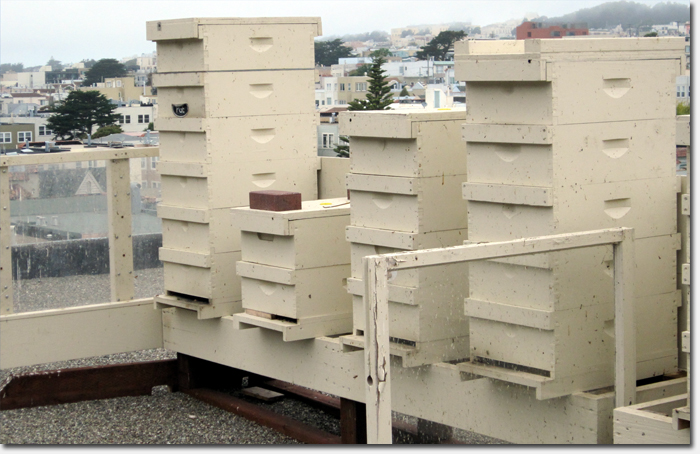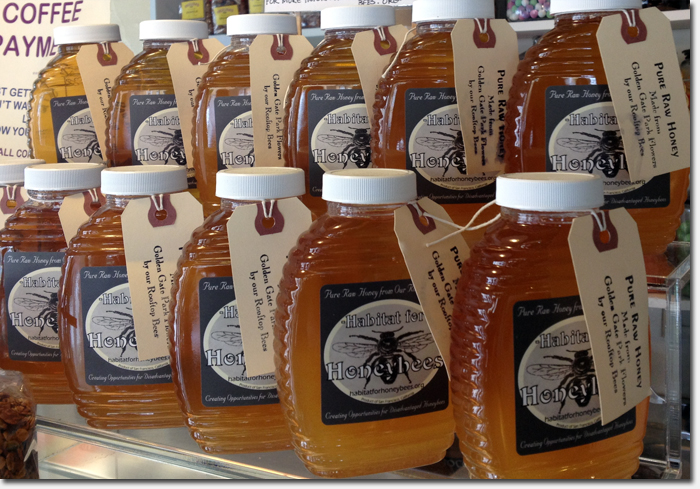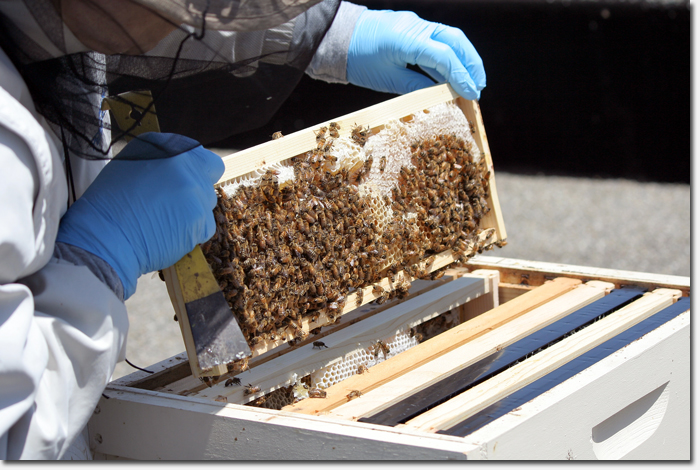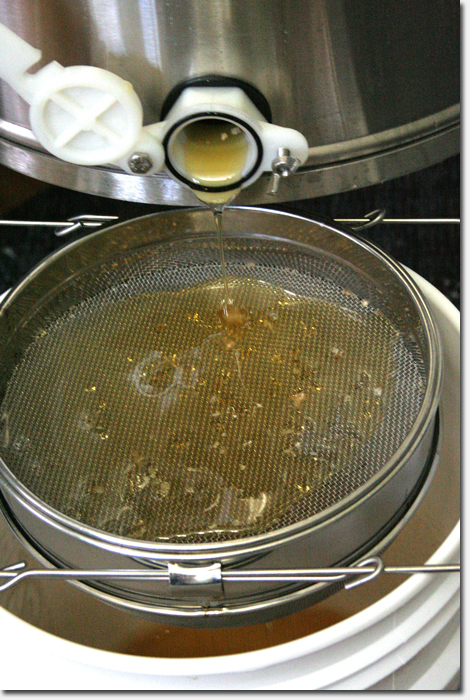
In early 2011, outer Richmond District resident Charlie B. attended an event at the Botanical Garden in Golden Gate Park. The San Francisco Beekeepers Association had a table with an “observation hive” on display, where plexiglass sides allowed Charlie to observe all the activity in the hive.
The impact on Charlie was immediate. “I have to do this. I HAVE to do this,” he remembers saying to himself.
He took a series of classes over 4 months from the Beekeepers Association to learn the fundamentals. With an investment of about $150, he got his first two “bee packages”, each one including a box containing honeybees and some sugar water to sustain them on their journey from the breeder in Orland, CA.
Fast forward to August 2012, and Charlie has made the most of his new-found hobby. Not only is he the current Vice President of the SF Beekeeping Association, but he also has 5 beekeeping farms and a honey business.
What began as a small hobby quickly captured Charlie’s imagination and time. He added himself to the “swarm list” on the Beekeeper’s Association’s website, becoming a local resource for residents with a honeybee problem.
“Swarms can happen anywhere – in a PG&E box, on a roof, on a tree in a yard… I go and take the swarm away in a cardboard box, and transplant them back to my bee farm here on the roof,” Charlie said.
What developed is a bee rehab center of sorts, aptly named Habitat for Honeybees, where Charlie nurses the bees back to a more sane existence in comfortable hives where they are no longer bothering residents. Happy bees means honey, and Charlie has lots of it.
Since January, he’s produced nearly 500 pounds of honey from his rooftop hives, which he bottles and sells, or gives away to neighbors and friends. Angelina’s Cafe on California and 22nd is where we first saw the honey for sale ($13) and learned about Charlie’s Habitat for Honeybees program. Bi-Rite Market on 18th Street also sells it.
How honey tastes all depends on where the bees forage, and for Charlie’s brood, it’s all about Golden Gate Park. His rooftop overlooks the park and the bees use it as their primary foraging ground. So what you taste in the honey is literally the product of wildflowers in Golden Gate Park.
“In the fall, it’s all about eucalyptus since it’s blooming in the park. The honey is darker then and has a slight eucalyptus flavor to it,” Charlie says.
So far he’s had good reviews about his honey. “We’ve been told it is extremely complex, almost spicy, with more understated flavors and notes, and definitely delightful. You might be able to taste eucalyptus, lavender, thyme, or whatever the bees happen across in the park while foraging,” he writes on his website.
The manufacturing of the honey is done in Charlie’s kitchen. After removing the frames with honeycomb from the hive, Charlie puts them in a box and takes them downstairs to his apartment where he triple filters the honey through mesh screens and packages it into bottles. Each one is stickered with the Habitat for Honeybees label designed by his wife, Jill.
Habitat for Honeybees’ honey and bees are all organic. No pesticides are used in Golden Gate Park and Charlie adheres to the same organic standards with his beekeeping.
“These are really healthy bees,” he says proudly.

Habitat for Honeybees honey is available at Angelina’s Cafe & Deli ($13, Calif. & 22nd)
We stopped by to check out Charlie’s honeybee habitat on the roof of his building on a foggy Saturday, so the hives were very quiet. The fog has the same effect on the bees as it does on us humans – they stay inside where it’s warm and hunker down.
“They keep the temperature of their hives around 94 to 96 degrees,” Charlie said. It was cold enough that he didn’t even want to open a hive and expose the bees to the cold. Only a few were buzzing around and bumping into us, checking us out.
“They’re very curious,” Charlie said.
On a sunny day, Charlie says the bees “like to party”, buzzing all around and foraging throughout the park. He has a variety of bee species in his hives, all European, ranging from German bees (“They’re the most productive”), to Italians and Carniolan honey bees, which are native to Eastern Europe and according to Charlie, “the most mellow”.
“These things are not just insects, ” Charlie marvels. “They have a social structure, they care about each other. It’s how society should be – everybody doing their job.”
It’s their social habits that seem to have most captured Charlie’s imagination.
The sole job of a drone bee is to mate with the queen so she can lay eggs and make more bees. When Charlie first started beekeeping, he noticed that a lot of drones were laying around outside the hive in the fall. That’s because the female worker bees had tired of feeding them, so they’d been kicked out of the hive – a natural part of the bee life cycle. But Charlie was new to beekeeping and not knowing this, tried to put them back in the hive.
“They just got assaulted all over again and kicked out by the worker bees! My beekeeper friends had to clue me in to that one,” Charlie said, laughing. Now he knows to just let them die and clear them away.
The mating process is particularly fascinating, Charlie says. The queen bee leaves the hive for the big event, where she is swarmed by drones who mate with her repeatedly for about an hour (a “drone cafe” it’s sometimes called). She then returns to the hive to lay eggs, and repeats the mating process again and again. Queens typically live for about a year and a half, other honeybees for about 6 weeks.
While the queen’s life sounds appealing, it can be rough for her too. Charlie says the fog and inclement weather can be challenging to the mating process. When a virgin queen first emerges from the hive for mating, fog and cold can disorient her and make mating difficult. If she returns to the hive and has not mated, it’s curtains for her. The other bees will finish her off and make room for a new queen who can do the job.
Charlie’s enthusiasm for beekeeping is infectious. He’s currently mentoring five other people in the ways of the honeybee, including another outer Richmond District neighbor. He’s expanded his beekeeping to five different farms in the Bay Area, producing honey from each of them.
He says he spends about two to three days per week tending to his honeybees, including producing and selling the honey, which helps pay for the maintenance of his hives. And he gets the occasional call to come remove a swarm, sort of like a Superman for honeybees.
“I was fascinated, and I never thought I would be,” Charlie says about his beekeeping.
We were pretty fascinated too and went home with a bottle of Habitat for Honeybees honey, which we have to say is delicious, and tastes wonderfully familiar – almost like it’s from our own backyard. 😉
Sarah B.


One of the filtration steps in the honey making process
Thanks for such a wonderful story. I’ll definitely stop by Angelina’s cafe to get a bottle! Questions: Has he ever been stung? How do you find another queen bee after she is gone to bee heaven?
@Toby – Yes, Charlie has been stung a fair number of times, he seems to take it in stride. I think the more experienced he’s gotten, the less frequently he gets stung. 🙂
I asked the same question about the queen bee. When they need a new queen, the worker bees feed “royal jelly” to some larvae, creating a few queen bees that are born at the same time. The new queens then battle it out and the strongest one becomes the hive queen. Survival of the fittest!
Sarah B.
This is a wonderful story, I love hearing about local projects like this. My wife and I live at 33rd/Fulton and she has pretty bad allergies. I’ve heard that eating local honey can help, and this honey can’t get any more local! We’re definitely stopping by and picking up a jar!
Great story, and can’t wait to get some!
Thank you so much for this wonderful story! I live at 26th/Fulton and also suffer from seasonal allergies — definitely will be headed over to Angelina’s to pick up a jar!
Yeah, I have the same problem with allergies as Tracy so will definitely be trying some!
Thanks for this great article, Sarah. I’m going to stop by for a bottle too. One thing, tho: I was inhaling the fragrant roses in the Rose Garden (GG Park) a few years ago, and then noticed a signing about the plants having been recently sprayed for insects. I’m pretty sure they were using insecticides, at least at that time. Charlie might want to double-check on the no pesticides in GG Park info.
Really great article! Thanks!
I recently took a course on bee-keeping at the Golden Gate Park Arboretum, but I think this article was more functionally-informative. I’d still like to do it, but it does seem to require a fair amount to learn (I had wanted simply to provide them a shelter and then let them fend for themselves, but there is an obligation to address swarming and provide some care and tending). I look forward to checking out the SF Bee Keepers Association.
Nice article!
The planet could always use more bees:)
Great article. Makes one want to start their own hive. Thanks.
Love this story! I will be another one running down to Angelinas!
Local honey can be beneficial (and usually tastier); but be a little cautious in eating honey produced from pollen that are allergens for you. I would recommend starting with tiny servings and slowly increasing the serving size. This is just a safety precaution since, your histamine reaction maybe different when ingesting the allergen (anaphylaxis vs. stuffy nose and cough). Here’s good info about honey (and it’s not biased): http://allergies.about.com/od/controversialtherapies/f/honeyallergies.htm
I personally want to try the current batch, not because of allergies, but because the eucalyptus sounds yummy.
Sarah, this is a wonderful story, and so thoroughly reported. Thank you so much for the time and care you put into creating, finding, and organizing content and information on this blog for us in the ‘hood, and for our greater SF community. You are much appreciated!
@Jennifer – You’re welcome! Glad you enjoyed it
Sarah B.
Went down to Angelina’s this morning and got the last bottle. Can’t wait to try it. Hopefully they’ll be replenishing their stock soon!